OUR PURPOSE and MISSION
The American Bladesmith Society, Inc. (ABS) was incorporated as a non-profit corporation to operate for educational, scientific, and charitable purposes. The American Bladesmith Society was formed primarily to encourage and promote activities involving the art and science of forging metal, particularly tools, weapons and art forms. The objectives of the educational programs of the ABS are to inform and educate knife makers and the public about the art, science, technology, history and culture relating to forged edged tools, weapons and artifacts and the proper care and use of these objects.
The original Board of Directors for the American Bladesmith Society was: William F. Moran, Jr., Bill Bagwell, Don Hastings and B.R. Hughes.
The History of the American Bladesmith Society
By: B.R. Hughes, ABS Founder and Secretary, Board of Directors
The American Bladesmith Society owes a tremendous debt of gratitude to the late W. F. “Bill” Moran. Without Bill there would be no ABS, no School of Bladesmithing, no ABS Hall of Fame and Museum, and in all probability, the art of the forged blade would not be alive today.
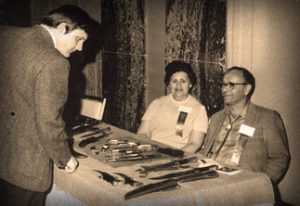 The seeds of the Society were sown at the 1972 Guild Show in Kansas City. Moran had been elected chairman of the organization, which is what they called the president in those days. He and I were chatting and he explained to me his dream of creating a group whose sole purpose would be the preservation and advancement of the forged blade. At that time, there were less than a dozen practicing bladesmiths in America, and this number was decreasing, not increasing, although the number of stock removal knifemakers was climbing dramatically.
The seeds of the Society were sown at the 1972 Guild Show in Kansas City. Moran had been elected chairman of the organization, which is what they called the president in those days. He and I were chatting and he explained to me his dream of creating a group whose sole purpose would be the preservation and advancement of the forged blade. At that time, there were less than a dozen practicing bladesmiths in America, and this number was decreasing, not increasing, although the number of stock removal knifemakers was climbing dramatically.
I know now that Bill had already made a few knives with hammer-welded Damascus blades, and I have been privileged to inspect the first such knife he ever made, but that didn’t occur until after his death February 12, 2006. However, at the 1973 Guild Show, also in Kansas City, Moran stepped down as chairman and at the same time he unveiled eight knives possessing Damascus blades. They were the talk of the show! Few people really understood their nature, but Bill handed out mimeographed sheets explaining not only what Damascus steel was, but basically how to make it! There was no charge for this sheet; Bill gave them away.
Permit me a side trip at this juncture. From time to time, I hear others claim to have made Damascus blades prior to Moran. Now, virtually everyone who was anyone in the world of knives was in Kansas City for the 1973 Guild show. All the big names were there, including Tommy Bish, Ken Warner, and John Wootters. None of these worthies questioned the fact that Bill was the first American to successfully turn out Damascus blades in the 20th century.
Now, back to the story of the ABS.
Moran’s reintroduction of Damascus steel gave bladesmithing a much needed shot in the arm. It was impossible to produce Damascus if one were not a smith, and immediately a number of knifemakers became interested in learning the art of the forged blade. It would have been virtually impossible for the ABS to have succeeded had not Damascus steel reentered the picture, courtesy of Bill Moran.
Others followed in his footsteps. A few months after the Guild Show, Bill Bagwell, a Vivian, LA smith, turned out his first Damascus blade, and a few months later, Don Hastings, a Palestine, TX smith, duplicated the feat. I cannot prove it, but I believe that Michael Connor, a Winters, TX, smith and protégé of Hastings’, was the fourth American smith to make Damascus, and the late Sid Birt, Nashville, IN was the fifth.
The 1976 Guild Show was held in Dallas. After the show, Bagwell invited Moran to visit him at his North Louisiana shop, and this offer was accepted. Bagwell then invited Hastings to attend the get-together, and at the same time, he invited me, as a knife writer, to come and share the fun. Also present was the late Bill Jordan, a noted gun writer who lived in nearby Shreveport at the time and was “Guns” Shooting Editor. During the day, the three bladesmiths forged a blade in Bagwell’s shop, heat-treated it, and rough finished it. Next they tested it, and Jordan could scarcely believe his eyes! A bit later, he published an article on the virtues of the forged blade which was reprinted with permission in the eighth issue of “The ABS Journal”.
After Jordan left, the four of us talked, and Bill Moran mused again of the need for an organization that might serve to preserve the forged blade. It was at this point that Moran said to me, “Bill, if we play our cards right, one of these days we could have 25 members!” I admired Bill’s enthusiasm, but I privately thought that the most we could hope for might be a dozen or so advocates. When we returned to our respective homes, we continued to work on the concept. We communicated by U. S. Mail and a couple of conference calls, which were paid for by Moran. Email would have expedited the process, but, unfortunately, it was not available at the time. Finally we though we were ready. On December 4, 1976, Moran flew into the Shreveport airport, where Bagwell, Hastings, and I joined him in that facility’s coffee shop. We had a pretty good grip on what we wanted, and we drew up the bylaws on a lined notebook. Moran was elected president, Hastings treasurer, Bagwell secretary, and I became the first director.
We grew slowly. In 1977 we added the late Jimmy Lile to our board as a director. Jimmy was a past president of the Guild, and he served as a liaison officer with that group. Somehow, a rumor started that we were in competition with the Guild, and nothing could have been further from the truth. We all thought the Guild was a grand idea, but we wanted to preserve the forged blade. It was that simple.
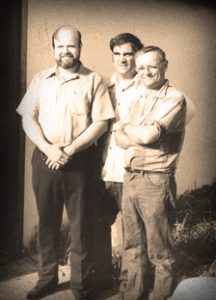
It should be noted that awarding journeyman and master stamps was not a part of our original bylaws. This was added later, and at the New York knife show in 1981, the first master bladesmith ratings were awarded to, in alphabetical order: Bill Bagwell, Jimmy Fikes, Don Fogg, Don Hastings, Bill Moran, and James Schmidt. As a sidelight, Moran felt that if he could get a celebrity to make the presentations, it might create a little interest. Deborah Harry, the rock star, was at the show with her husband, who was a knife buff. Ms. Harry was kind enough to award the stamps, and, as the crowd had been advised that this was going to take place, it created considerable interest. I have always doubted that Moran knew who “Blondie” might have been, since the attractive lady who handed him his stamp looked nothing like Dagwood Bumstead’s wife!
In 1984, Bagwell resigned his master’s stamp and his post on the board.
In approximately 1985, the ABS, in conjunction with the University of Wyoming, held its first hammer-in at Dubois Lakes, WY. The two Bills and Don comprised the faculty, and while the venture proved successful in the board’s eyes, the university chose not to continue the hammer-in. At this point, I approached James Powell, the Director of Continuing Education at Texarkana College, where I was Dean of Students. I suggested to James that it might be a good idea for TC to sponsor a hammer-in at nearby Washington, AR, where there was a replica of James Black’s smithy. There is rather substantial evidence that during the winter of 1830-1831 James Bowie stopped at Washington and purchased a knife from Black, whose replicated shop is a major point of interest at the State Park located there. The Black shop features a working forge, at which both Don Hastings and Bill Bagwell had served as resident smiths.
So it was that in April, 1984, the first Texarkana College spring hammer-in was held in Washington, with the four founders serving as instructors. Today, this seminar, named the Piney Woods Hammer-In, is still going strong and is the “granddaddy of the hammer-ins”.
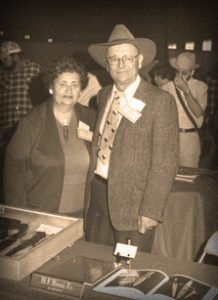 At approximately the same time that Bagwell resigned, Lile, for reasons related to his health, also resigned, and Hanford Miller and Jim Phillips were added to the board. Miller was a Maryland bladesmith and Phillips a military historian and writer from New Jersey. A bit later, Paul Burke, Sr., a Baltimore attorney, was elected to the board. By 1986, Hastings’ health was failing fast, due to leukemia, which had been in remission. He was not able to fulfill his teaching duties at the 1986 Piney Woods hammer-in, and James Crowell, a bladesmith from Mt. View, AR, who was to receive his mastersmith rating the following fall, ably filled his slot. Hastings died in September, 1986, and Hanford Miller was appointed to fill his post as treasurer. To honor the late founder, the ABS created the Don Hastings Memorial Award, which is the highest honor the ABS can confer. Other ABS awards include the Margaret Moran Silver Slipper launched in 2001; the W.W. Scagel Award instigated in 1998; the B. R. Hughes Award initiated in 1995; the W. F. Moran Award, first presented in 1998; the Antique Bowie Knife Collector Awards, instigated in 1995; and the George Peck Award which began in 1994.
At approximately the same time that Bagwell resigned, Lile, for reasons related to his health, also resigned, and Hanford Miller and Jim Phillips were added to the board. Miller was a Maryland bladesmith and Phillips a military historian and writer from New Jersey. A bit later, Paul Burke, Sr., a Baltimore attorney, was elected to the board. By 1986, Hastings’ health was failing fast, due to leukemia, which had been in remission. He was not able to fulfill his teaching duties at the 1986 Piney Woods hammer-in, and James Crowell, a bladesmith from Mt. View, AR, who was to receive his mastersmith rating the following fall, ably filled his slot. Hastings died in September, 1986, and Hanford Miller was appointed to fill his post as treasurer. To honor the late founder, the ABS created the Don Hastings Memorial Award, which is the highest honor the ABS can confer. Other ABS awards include the Margaret Moran Silver Slipper launched in 2001; the W.W. Scagel Award instigated in 1998; the B. R. Hughes Award initiated in 1995; the W. F. Moran Award, first presented in 1998; the Antique Bowie Knife Collector Awards, instigated in 1995; and the George Peck Award which began in 1994.
By this time the ABS was holding an annual exhibition in conjunction with the Tulsa Gun Show, the second largest show of its type in the U. S. at that time. The Society met for three years in Tulsa, and slowly began to attract national attention. Joe Cordova, a smith from Bosque Farms, NM, and Jay Hendrickson, a Frederick, MD, bladesmith, were named to the board, along with Jeffrey Harris, a St. Louis businessman and knife collector.
It was during this period that the stipulations associated with attaining a journeyman’s stamp and a master’s stamps were formulated. These went into effect in 1988, and the first smith to attain a master’s under the new requirements was Wayne Goddard, Eugene, OR.
The year 1988 was a memorable one for the ABS. Moran had previously expressed his opinion that the ABS needed a school where bladesmithing could be taught. In 1986, while he was visiting Carolyn and me in Texarkana, Bill and I met with the Pioneer Washington Restoration Foundation in Old Washington, and presented our views on the vital role the Foundation could play in the preservation of an art form – bladesmithing. Judge James Pilkington, chairman of the group, and George Peck, a member of the Foundation and a banker and knife collector, loved the idea, and before the evening was over, the Foundation had voted to construct a suitable facility in Old Washington, with the stipulations that the ABS would provide instructors from the ranks of its master smiths, and that “someone” other than the Foundation would handle all of the administrative details. I went back to Texarkana College and recruited the assistance of James Powell, and we asked for an audience with Dr. Carl “Cheesy” Nelson, who was president of TC at that time. We made our best pitch, but Dr. Nelson was skeptical. “If it’s such a good idea,” he asked, “how come no one else is doing it?” At that time, fate intervened. Jeffrey Harris, who had recently attended one of our hammer-ins, called Dr. Nelson to express to the President his delight at what had been taught at Old Washington, and how well it had been presented. When Harris learned that Dr. Nelson was “considering” a proposal to create a bladesmithing school, Jeff said that if this came to pass, he would make a “significant” contribution to help get the school started.
That seemed to be the turning point. Dr. Nelson reasoned that if a very successful St. Louis businessman was willing to put his own money into a bladesmithing school, it must be a good idea! The first bladesmithing school in the history of the United States opened its doors on the first day of May, 1988. Having Texarkana College serve as administrator of the school has meant so much to the ABS. TC is a fully accredited institution of higher education, and this provided the school with instant credibility. James Powell served as the director until 1991, when the current director, Scotty Hayes, assumed leadership. One of Scotty’s first actions was to instigate a fall Piney Woods Hammer-in. The school was an immediate success, and it proved Moran was right, because the membership of the ABS began to grow rapidly.
In 1988 the master smiths on the Board of Directors decided to make a knife using the combined efforts of these smiths which would be auctioned at the Society’s annual meeting. This custom continues to the present and the record price for one of these knives was achieved in 2006 when a version of Bill Moran’s famous ST-23 featuring the last Damascus blade he had forged was sold for $37,000. In 1990, the ABS Master Knife of the Year Program was launched in which a master’s name is selected at random from a group of volunteers to make a knife which will be auctioned at the Blade Show. This program extended in1997 to include an ABS Journeyman Knife of the Year and the following year an ABS Master Folder was added. The generosity of ABS members has helped to make the auctioning of these four an anxiously anticipated event at the annual show.
In 1989 Gordon Bloomquist, a lobbyist from Oregon, was named to the board and served until 2001.
In 1991, after 15 years of leadership, during which he did not receive so much as one penny from the Society, Bill stepped down as president. Jay Hendrickson was elected to be the new ABS leader, and Moran’s last official action as chairman to appoint Joe Keeslar, a mastersmith from Almo, KY, to the board. But the ABS leaders would not allow Bill to retire so easily! They unanimously elected him “Chairman Emeritus”, meaning that he would serve on the board for the balance of his life, if he chose to do so and he did just that!
Jay proved to be an able administrator, and he filled in many of the blank spots that had been empty during the Society’s first 15 years. Moran was an inspirational leader, but he was not a “detail man”. Hendrickson was, and many of the current ABS policies were established during Jay’s reign. In 1994, Dr. James Batson, a mastersmith from Madison, AL, and Jerry Fisk, a masterfrom Lockesburg, AR, were named to the board. Joe Cordova succeeded Hendrickson in 1995.
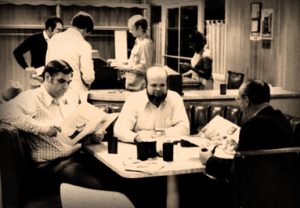
The annual show of the Society had been shifted to the Blade Show, then in Knoxville, TN, in 1987, and later the site was shifted to Atlanta, GA, where it remains today. “Blade Magazine” has proven to be a good overseer of “The World’s Number One Knife Show”, and both the ABS and “Blade” have profited from this association.
Paul Burke, who had obtained tax-exempt status from the IRS for the Society in 1985, died in 1999. Dr. Batson assumed the reins of leadership that same year, and proved to be a creative and imaginative president. Johnny Perry, a South Carolina businessman, had been elected to the board in 1997, and a year later, Houston Price, publisher of “Knife World”, became a director. Hanford Miller, who had served as treasurer after Don Hastings’ untimely death, retired from the board in 2002. Greg Neely, a master from Houston, TX, the current ABS president, was elected to the board in 1998. In 2002 Bert Gaston, a master from Little Rock, AR, was named to the guiding body, as was Rick Dunkerley, a master from Seeley Lake, MT. The following year, 2003, Steve Dunn, a master from Smiths Grove, KY, was named a director, and in 2004 Harvey Dean, a Rockdale, TX, master, was elected to the board. In 2003 Joe Keeslar took over as president, and provided a smooth, steady hand at the helm.
The ABS launched its own museum and hall of fame in Little Rock, AR in 1995 in conjunction with the Historic Arkansas museum, located in downtown Little Rock. This is a highly respected facility, and the exhibits there take a back seat to no museum in the country! The most recent Hall of Fame induction ceremonies took place in 2006. The first year inductions were held in 1996 and these were in the “first class”: James Black, Jim Bowie, Don Hastings, B. R. Hughes, W. F. Moran, and W. W. Scagel. In 1997 the ABS inducted Houston Price, W. D. Randall, and R. H. Ruana. In 1999 James Lile and Ken Warner were elected. In 2001 Dr. James Batson, Paul Burke, Jerry Fisk, Bruce Voyles, and Daniel Searles were inducted. In 2003 Samuel Bell, Jeffrey Harris, Margaret Moran, Al Pendray, and Steve Shackleford were inducted and in 2006 Clyde Fischer, Don Fogg, Jay Hendrickson, and Henry Schively were inducted. If you’ve never visited the ABS museum and Hall of Fame, you should. It’s something of which the Society and its members can be very, very proud.
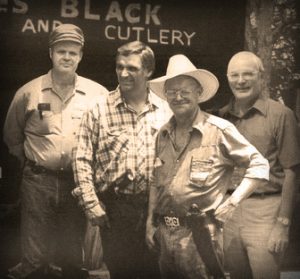
Inspired by the success of the Piney Woods Hammer-In, the ABS began to sponsor a series of weekend seminars of its own. The first of these events was held in August 2001 in Fruitport, Michigan with the assistance of Dr. James Lucie. The following year the Michigan Hammer-In was moved to Mike Bauer’s farm, also near Fruitport, where it remained through 2004. Additional ABS hammer-ins have been held in California, Maryland, Montana, New York, North Carolina Winston-Salem and Haywood Community College in Clyde, and Ohio. ABS members have also been very active in weekend seminars held in Alabama, California, Texas, France, New Zealand, and South Africa. The ABS Hammer-In Program is under the co-direction of Dr. James Batson and Mike Vagnino. For the most part, Dr. Batson handles hammer-ins East of the Mississippi and Vagnino coordinates those west of the river.
In 2003, the ABS blazed new trails with an All-Forged Blade Exposition held in Reno, Nevada. This has proven to be a most successful undertaking and some observers have termed it, “the classiest knife show in America”. The last Reno Expo was held in 2008 and in 2009 the extravaganza moved to San Antonio, Texas, the home of the Alamo.
The ABS has also stressed its youth program and has interacted with the Boy Scouts of America and the 4-H Organization on a number of occasions. The first ABS youth hammer-in was held in 2007 in Tennessee. Wes Byrd and Larry Harley have been extremely active in the promotion of this phase of the society’s efforts to reach the youth of America. Tim Potier joined the duo to present a series of demonstrations to the students of the French Camp Academy in Mississippi.
In January, 2008 Robert Calvert, a banker-businessman from Rayville, LA, was added to the governing group. Robert is a journeyman smith, but he was added to the board for his business acumen. Another change on the Society’s board occurred in January, 2008, when Jerry Fisk submitted his retirement as second vice-president, having served almost 14 years on the ABS’ governing body and contributing greatly to the ABS in numerous undertakings. On December 1, 2008 Dan Cassidy, a former career federal prosecutor and Journeyman Smith from Salida, Colorado was elected to the board. In August, 2009, at the board meeting in San Antonio, Texas, Bill Wiggins, a Journeyman Smith from Canton, North Carolina was added to the board.
During 2010 and 2011 after many years of distinguished service in various capacities, Johnny Perry, Rick Dunkerley, and Bert Gaston resigned from the ABS Board. In 2011 Master Smiths Dr. Dan Petersen from Kansas, Kevin Cashen from Michigan, Michael Vagnino from California, and Mark Zalesky, the editor of “Knife World”, were elected to the ABS Board of Directors.
Bill Moran, who died in Frederick, MD, February 12, 2006, was a staunch believer that the ABS Board should not be composed only of bladesmiths, although only a mastersmith may serve as Chairman of the Board and president. Moran felt strongly that the board should include businessmen, historians, journalists, and the like, as well as smiths, to provide a sense of balance. The history of the ABS has proven that Moran, as usual, was right. The sole purpose of the Society today is the same as it was in 1976 – to promote and preserve the art of the forged blade, and the path chosen to accomplish that goal is one of education. It is the mission of the ABS to teach smiths how to turn out completed knives that due to their quality and artistry will be marketable to the public. Teaching is the role of the ABS.
Bill Moran Father of the American Bladesmith Society
Bill Moran, 80; Damascus Steel Bladesmith
By Joe Holley Washington Post Staff Writer
© 2006 The Washington Post Company
Wednesday, February 15, 2006
In 1973, Frederick County bladesmith Bill Moran created a sensation among knife enthusiasts worldwide when he single-handedly revived the lost art of forging Damascus steel, an alloy prized by sword smiths during the Middle Ages because of its strength and flexibility. Mr. Moran, known as “the father of modern Damascus,” died of cancer Feb. 12 at Frederick Memorial Hospital. He was 80.
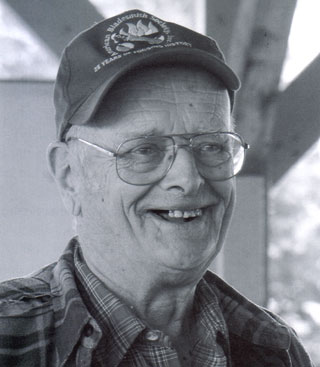
For more than 60 years, he crafted knives of such superb quality that they lured the likes of Jordan’s King Abdullah II and actor Sylvester Stallone to his tiny soot-streaked workshop on the west side of Braddock Mountain, near Middletown, Maryland. He made his knives by hand from the very best materials — forging the steel, inlaying the precious metal, carving the handle, even stitching the sheath. He made many of his tools as well.
Twenty-five or so years ago, he charged about $500 for one of his better knives. Recently, one of his Bowie knives went for about $30,000. A friendly, self-effacing man who loved jokes and stories, William F. Moran Jr. was born in Frederick to a dairy farmer. He forged his first knife at age 12. “He told me one time he would steal tools from his father, farm implements and saws and things like that, to make knives,” said Jay Hendrickson, a Frederick knife maker and old friend. By 14, he was selling knives. He taught himself how to forge a blade, he told The Washington Post in 2003, by asking local blacksmiths “and getting all the wrong answers.”
School bored him, but he loved trapping and fishing along the Monocacy River. And he read every book on knives he could find. He also nosed around hunting shows and attended a woodcarving exhibition in Washington. He built his first forge on the family dairy farm, near the village of Lime Kiln, while still a teenager. “There were only a few people forging right after the war,” Hendrickson said. “He didn’t want that art to be lost.” By the mid-1950s, he was selling knives through a rudimentary catalog and was one of only a few custom bladesmiths in the country. In 1960, he sold the family farm and built his shop.
Mr. Moran began trying to revive the ancient process of forging Damascus steel in the late 1960s. Germanic tribes had perfected the process in the first millennium and the Nazis had briefly resurrected it, but no bladesmith in the United States knew the technique. Without a recipe for the process, it was in danger of being lost. “He knew you could weld iron together, because he had done it on the farm,” Hendrickson said. “It took a lot of trial and error and a lot of mistakes.” Damascus is made of iron and steel, welded into three layers, heated and hammered flat. Mr. Moran would then fold the piece, re-weld it and hammer it out again. He would repeat the process eight times, exponentially multiplying the layers into as many as 500. Mastering Damascus steel, the consummate craftsman became the artist. That transition was a bit distressing to Mr. Moran, who liked to see his knives used, not merely displayed.
One of his most unusual knives was made out of a meteorite. “I tried to forge the meteor into a flat shape, and, of course, it started to crack because it had dirt in it,” Mr. Moran explained on the American Bladesmith Society’s Web site. “So I started folding it. I folded it ten times and then welded a piece of W-2 steel in the center to make the blade.”
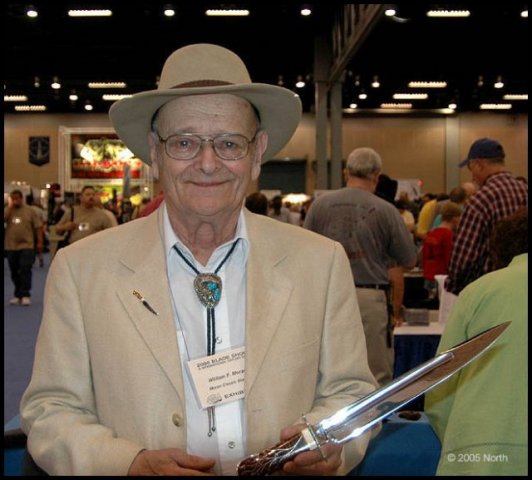
Stallone heard about Frederick County’s master bladesmith in the late 1980s and ordered “the most elaborate knife I could make,” Mr. Moran told The Post. He made a curved, Asiatic-looking Damascus steel combat knife, its handle and case inlaid with more than 30 feet of silver wire. It cost the actor about $7,000. King Abdullah visited Mr. Moran in the early 1990s. Standing in the shop, its old floor stained with tobacco juice, he ordered a long, slender combat knife with a maple handle inlaid with pure silver. “It cost about $3000,” Mr. Moran told The Post. “He also gave me a Swiss watch. Very nice man. I never met a king before — but, of course, he was only a prince then.”
He founded the American Bladesmithing Society in 1976 and the American Bladesmith School in 1988 to perpetuate the craft. He selected Washington, Ark., as the school’s headquarters, because it was said to be the place where legendary blacksmith James Black crafted at least one knife for Jim Bowie himself. A knife maker who wants to earn the sobriquet “master bladesmith” at Mr. Moran’s school must be able to make a welded Damascus steel knife that is sharp enough to cut a one-inch-thick piece of rope and sturdy enough to slice a two-by-four in half while retaining enough of an edge to shave the hair off an arm. The knife also must be able to bend 90 degrees without breaking.
At the height of his career, Mr. Moran was crafting about 40 knives a year, but in recent years he was making a half-dozen or so. He sold every other year at an invitation-only show in San Diego. His wife, Margaret Moran, died in 2001. There are no immediate survivors. Mr. Moran willed his forge and tools to the Frederick County Landmarks Foundation. “I’d like to see it get used,” he told The Post in 2003.
© 2006 The Washington Post Company
